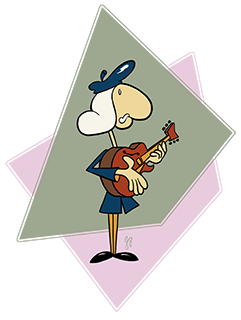Thirds and sevenths are the best tones to hit in your passage over a given chord to outline it's harmony. From those two tones, you can instantly distinguish between Major/Minor/Dominant. Minor thirds immediately highlight the minor sound and the flat seventh will immediately signal 'this is not a major chord.'
Once you know how to introduce a phrase with a flat third over a minor chord and a flat seven over a dominant, your listeners will instinctively hear the chord progression just in your solo phrases alone.
Eventually you should take a song and, for each bar, start your phrase with the appropriate third or seventh for that bar's chord.
It is key that you start with 'guide tones' as your target tones, but eventually you will want to break out of the habit of always grabbing those notes first to start a phrase over a chord.
Once you are ready to expand beyond the guide tones, try this exercise:
Pick out another scale tone and map it over the chord passage. For instance -- take a ii-V-I and start the measure with the ninth of each chord. For a four bar ii-V-I in C major, you will start bar 1's phrase with an E (the ninth of D-7). On bar 2, start a phrase with an A (ninth of G7), and finally start your bar 3 phrase with a D (ninth of Cmaj7).
Once you are comfortable with the ii-V-I, grab a standard you know fairly well and go through the whole tune starting each phrase with the ninth and then continuing to improvise with the scale or arpeggio you've chosen for that chord.
The next 'target tone' to start each phrase with may be a thirteenth. Map out what the thirteenth is for each chord and play that note to start your phrase when that chord comes along. Start with a simple set of changes and then move on to a song. Then maybe to a song with more complex harmonic modulations.
After that, move on to all the other tones. What if you play a b3 to start every chord -- even the dominants and major chords? Can you make it sound musical? Can you make it make sense? How about a b5/#11?
Once you are confident of finding a certain interval for any chord in a progression, practice 'leading in' to that target tone from the preceeding chord's notes/scale -- especially when the tune 'hangs' on a chord for more than one bar.
For instance, in your looped four-bar ii-V-I in C major ( D-7 / G7 / Cmaj7 / Cmaj ):
On the last bar, take a rest on the first half of the measure and then resume soloing in your C major arpeggio leading into your target tone for D minor and continue in your D minor arpeggio or scale without stopping.
Some tunes to try this on for the starkest effect might be the modulation to the B section of 'So What', going into the fifth bar of 'Green Dolphin Street', going into the half-step modulation for the B section of 'Girl From Impanema', the third bar of 'Solar,' etc. The goal is to move to these target tones as fluidly as possible, even from an 'alien' harmony.
Once you know where all the intervals are for a chord, it will be harder to get lost. It's like when you are walking in a city and every turn you make, you see a building you recognize, no matter what neighborhood you venture to. Even if you wake up and get off a bus or pop up from a new subway station -- as soon as you see that landmark, you can quickly navigate to anywhere you want to go.
This exercise will not only help you identify the intervals across your fretboard for any chord harmony, but it will also reinforce that interval's sound against the chord's harmony. For instance, starting with a 13th (same as sixth) on a Major sound will briefly cue your ear into that chord's relative minor. You will probably find certain intervals you gravitate towards for different chords and passages.

 RSS Feed
RSS Feed
